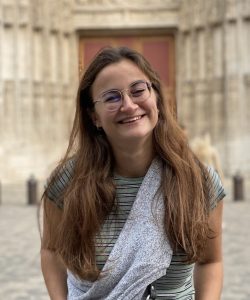Bionote

In 2020, Marit Hendrickx graduated with a MSc in Bioscience Engineering (Agricultural Sciences) from KU Leuven, Belgium. During her master’s programme, she specialized in crop production and the use of soil moisture sensors for irrigation scheduling. She started her PhD at the Department of Earth and Environmental Sciences at KU Leuven, in collaboration with the Soil Service of Belgium. Her research was part of the VLAIO-funded DRIP project, which investigated the application of drip irrigation in vegetable production. Her main focus lies on improving irrigation scheduling based on soil moisture predictions with the aid of inverse modelling, combining soil water balance modelling and soil moisture sensing. In 2021, she was granted a personal FWO fellowship.
Presentation Abstract
Efficient water management is crucial for sustainable agriculture, especially in vegetable production, where irrigation plays a key role in ensuring optimal yields and resource efficiency. This study presents SWIM² (Sensor Wielded Inverse Modeling of a Soil Water Irrigation Model), a digital twin framework that integrates real-time soil moisture monitoring with data-driven modeling to support irrigation decision-making. Using the DREAM(ZS) Bayesian inverse modelling approach, 12 soil and crop growth parameters are estimated with their associated uncertainties. By continuously calibrating a soil water balance model using in situ sensor data and soil moisture samples, SWIM² predicts soil moisture dynamics for the next seven days, incorporating weather forecasts to optimize irrigation scheduling. A field trial with Belgian endive in Flanders demonstrated the system’s capability to reduce water use while maintaining or improving crop yields. The framework is user-friendly, cost-efficient, and accessible via an online platform, allowing farmers to make informed, data-driven irrigation decisions. This approach enhances water use efficiency, reduces environmental impact, and automates irrigation planning, ultimately contributing to more resilient agricultural practices.
Co-Authors: Jan Vanderborght1,3, Pieter Janssens1,4,5, Sander Bombeke6, Evi Matthyssen7, Anne Waverijn8, Jan Diels1,2
1 Department of Earth and Environmental Sciences, KU Leuven, Heverlee, 3001, Belgium
2 KU Leuven Plant Institute (LPI), KU Leuven, Leuven, 3001, Belgium
3 Agrosphere Institute IBG-3, Forschungszentrum Jülich GmbH, Jülich, 52425, Germany
4 Soil Service of Belgium, Leuven, 3001, Belgium
5 Department of Biosystems, KU Leuven, Leuven, 3001, Belgium
6 Proefstation voor de Groenteteelt, Sint-Katelijne-Waver, 2860, Belgium
7 Praktijkpunt Landbouw Vlaams-Brabant, Herent, 3020, Belgium
8 Viaverda vzw, Kruishoutem, 9770, Belgium